Seven Impossible Interviews
Before Breakfast #79: Ed Young
 February 9th, 2009 by Eisha and Jules
February 9th, 2009 by Eisha and Jules
Jules: How can we even begin to describe, as the big fans we are, how exciting it is to have renowned Caldecott medalist Ed Young stop by for a chat today? Young has brought us over eighty illustrated picture book titles — visually-delightful works of the imagination, as well as countless adaptations and re-tellings of the old folk tales and fables of our world, often rendered in paper-collage. If I were asked to name a contemporary illustrator whose works provide a truly exciting visual experience, no matter the book’s tone, Young would be the first to come to mind. Whether he’s using the bold, bright collage of a book like The Emperor and the Kite (written by Jane Yolen and published in 1967) or bringing us ethereal impressionistic paintings, such as in 1989’s Lon Po Po: A Red Riding Hood Story from China, it’s always dramatic. Always striking. Always infused with an elegance. You look at his illustrations, and you can see the poet in him.
Eisha, could you even pick your favorite Ed Young title, or would it be way too hard?
P.S. Ed asked us: What are the seven impossible things? Shoot, I don’t think we’ve ever addressed that. To me, everything is impossible, pre-breakfast, until I’ve had coffee. Sadly, I’m not just trying to be cute.
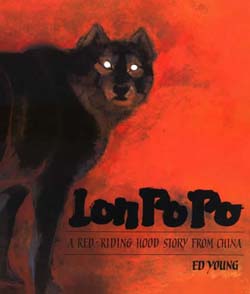 eisha: A favorite? A single favorite, you mean? Nope, can’t do it.
eisha: A favorite? A single favorite, you mean? Nope, can’t do it.
I can tell you that Lon Po Po was probably my first introduction to his work, and I loved it deeply for it’s brilliant composition and fine edge of creepiness. But I also loved using Seven Blind Mice in library storytimes – kids always love the big reveal at the end. Mouse Match is very cool – I love the way he made use of the accordion book format to create a fresh and contemporary take on a traditional form – kind of like he did with the story itself. Ooh, but also, did you see Beyond the Great Mountains? That was so quietly beautiful, and again, he made great use of innovative design to show his torn-paper collage to its best advantage. But no, I couldn’t possibly just pick one.
So, what about you, Jules? Got a single favorite?
p.s. – Hmm. Sadly, I think for me most days, the impossible things I have to make myself believe before I can face the world are things like “I can do this” and “Everything’s going to be just fine.” But that’s way too maudlin to say to Ed Young. How about: it’s different for everybody, and it’s different every breakfast.
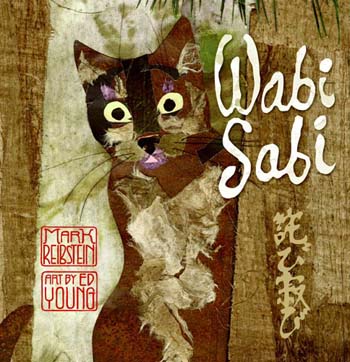 Jules: That’s putting it well, Eisha. How about, possibly: We’re different every breakfast, not to mention every breakfast is different.
Jules: That’s putting it well, Eisha. How about, possibly: We’re different every breakfast, not to mention every breakfast is different.
Yes, it’s also way too hard for me to pick a favorite, but I will say that Wabi Sabi, written by Mark Reibstein and published by Little, Brown last year, is right up there on my list. And not just ’cause I have two gorgeous spreads from it to share today. I won’t go on about it again here; I blogged about it back in December. In that post, I also linked to Alvina Ling’s posts at the Blue Rose Girls about the story of the book’s long road to publication, including the tale of how Young’s original art work for the book went missing. Fascinating story. Simply beautiful book.
And, speaking of his new books, scattered throughout this interview are some images from Ed’s newest illustrated title, Tsunami! by Kimiko Kajikawa, just released by Philomel Books in February. The story is adapted from Lafcadio Hearn’s “A Living God” (from Gleanings in Buddha-Fields, published in 1897). Ed uses collage, pastel, and gouache to illustrate the tale based on Japanese hero Hamaguchi Gohei, who in 1854 made a huge personal sacrifice during the approach of a tsunami to save the lives of many. It is a moving story of loss and the power of goodness and sacrifice for the sake of community. I’ve not seen the book yet, but I’ve seen .JPGs of the spreads, and Ed’s work is, as always, visually powerful. Just look at the cover here below. How one can do that with paper is beyond me. (For a way more detailed analysis of the cover, don’t miss Betsy Bird’s late-January review of Tsunami! As always, the review is thoughtful, detailed, and spot-on.)

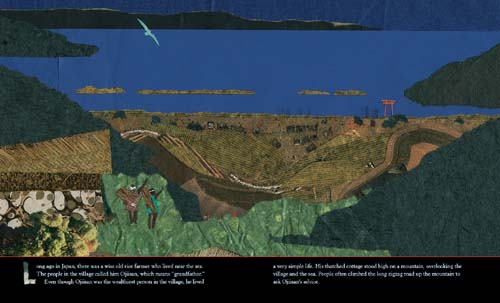
If you scroll down, you’ll see (later in the interview) the spread of the wall of water about to hit the small village of the story, and it’s positively terrifying. That’s a compliment; it’s a riveting tale.
We’d like to thank Ed for taking the time to do this interview, especially since I believe his preference was to conduct the interview via phone, yet I’m not quite equipped here at my home, in many ways, to do an interview justice in that matter. Ed hand-wrote his responses, and his agent’s assistant, the honorable Ms. Abigail Shepard, transposed them into email for me (which I had no idea she was going to do, or I would have tried to talk her out of all that work). So, I send hearty thanks to Ms. Shepard as well. “Some {responses} are probably better in person than in the written form,” Ed told me. While we wish we were having an actual, face-to-face breakfast with him (hey, we can dream), we thank him for his flexibility in trying to get this interview to our readers.
Since Ed answered the interview questions, as he put it, “the best I could in the order that would inform best,” I’m going to format the interview in that manner. We’ll begin our interview then with the Pivot Questionnaire. It’s usually how we close our author and illustrator chats, but Ed answered it first (which I find fitting, since I happen to think the responses to this questionnaire tell you a great deal about a person, but I digress).
7-Imp: What is your favorite word?
Ed: “AHA!”
7-Imp: What is your least favorite word?
Ed: “Can’t,” “Impossible.”
7-Imp: What turns you on creatively, spiritually or emotionally?
Ed: A well-told story.
7-Imp: What turns you off?
Ed: Insincerity.
7-Imp: What is your favorite curse word? (optional)
Ed: “Heartless.”
7-Imp: What sound or noise do you love?
Ed: Sound of waves lapping the shore.
7-Imp: What sound or noise do you hate?
Ed: High-pitched screech.
7-Imp: What profession other than your own would you like to attempt?
Ed: Drama or film-making.
7-Imp: If Heaven exists, what would you like to hear God say when you arrive at the Pearly Gates?
Ed: “You are here already? Go back down and finish what you started, where you’re most needed.”
7-Imp: What initially drew you to Mark Reibstein’s wonderful Wabi Sabi? What was it like to read that text for the first time and to explore the potential relationship between his story and your art work?
Ed: There is the vision of Mark Reibstein to introduce a concept similar to my own and a way of life which must be experienced rather than be told in words. In addition, in the text, Haiku in Japanese and English must be included.
It was not an easy book to make and I took it on as an exercise and a challenge.

7-Imp: You’ve said before that “producing a book becomes part of the spirit of each person who touched it.” What did you learn about the people who helped bring Wabi Sabi to publication, particularly after the rather arduous journey to publication the book had (the lost art, etc.)
Ed: The spirit of each person who touched it (and those who’d touched them), not to mention whoever took the “lost art,” and my wife, who passed away during that interim—they all challenged me unwittingly to move forward to create what is now the Wabi Sabi book. For that, I am grateful.
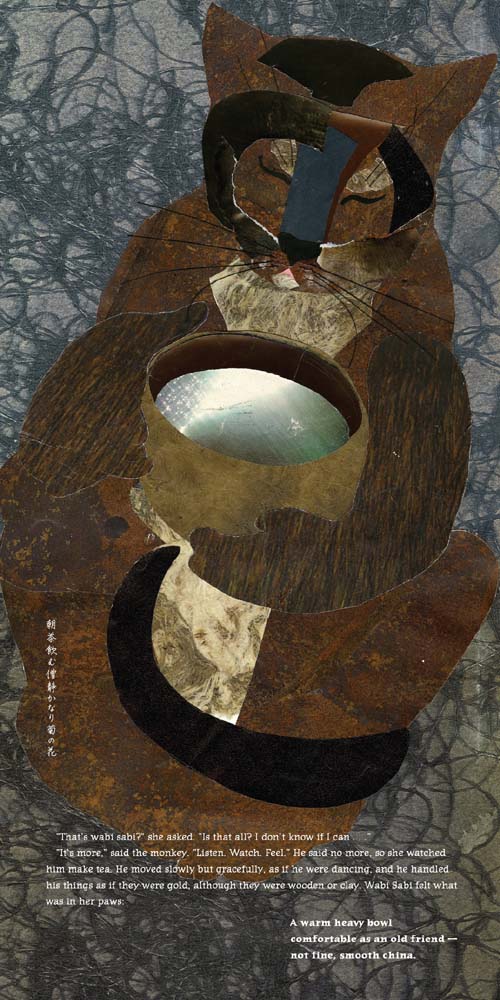
7-Imp: At a Horn Book ceremony in which you once spoke, you talked about the “Eight Matters of the Heart,” the place where you say you put your mind before you do your work. Can you elaborate on that a bit for those who never heard that acceptance speech (or saw the poster or read Voices of the Heart)?
Ed: We put ourselves in jeopardy in life if we don’t have our mind and body in the right place. The eight matters must accompany me wherever I tread so that I know the time that I have in this world is well spent (for one never knows if I’ll be here again for another round).
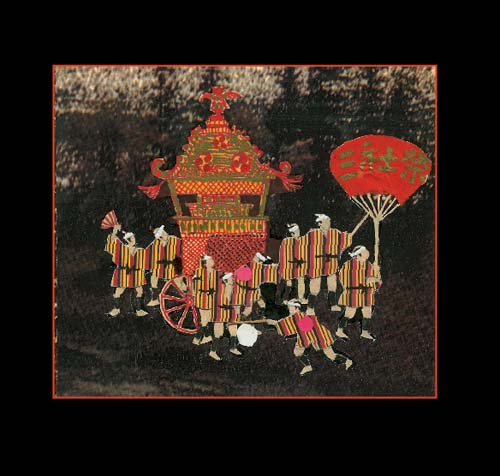
7-Imp: You’ve talked before about how you feel you’ve always been an artist and that it came naturally to you — almost as if you had no choice in becoming one and that putting your imagination on paper was something you had to do. How do you think elementary schools can best serve students as passionately interested in art as you were as a child? Is there a difference in how art is taught in China, where you grew up, compared to the U.S.?
Ed: Visual art is about expressing one’s vision visually. Yes, art is taught differently in different parts of the world, but the method is not as important as how it is taught.
In the East, the emphasis is on freeing the mind and body, and to see things deeply beyond its outer form through observation. In the West, it’s about celebrating the joy of art and one’s unique vision and expressions.
In the end, it is the teacher who can challenge and ignite that passion to excel, to become at home within oneself, that really matters.
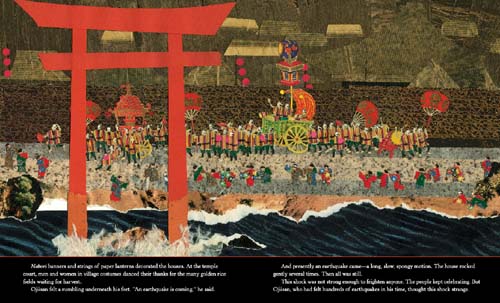
7-Imp: What exactly is your process when you are illustrating a book?
Ed: I usually begin illustrating a book as I read and am inspired by the text of the manuscript, long before any publisher is aware of it. As everyone in the business knows, manuscripts usually bounce from house to house a bit before they land in the right place at the right time. It is at that point it goes into its final stages of development, such as format, sizes, medium, design, choice of paper, type faces, colors, and styles.
7-Imp: Name one way in which your experience growing up in Shanghai during World War II affects your work.
Ed: Since I was brought up under the Japanese occupation of WWII, things were scarce, including paper. I used to draw on the blank spaces on my textbooks and newspapers. All that has become a part of me, even if I have lived in the U.S. for half a century already.
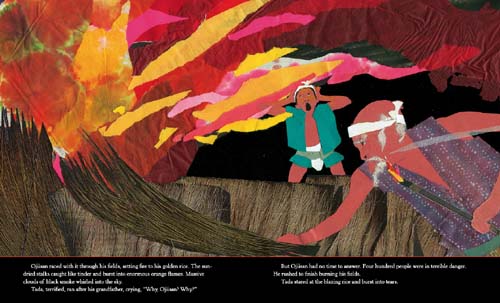
7-Imp: The New York Times wrote that your choice of medium (collages) in Wabi Sabi is “a metaphor for the gentle philosophy explored {in the book}.” Did you deliberately intend to reflect the worldview that is wabi-sabi by choosing to use the materials you used to create the illustrations?
Ed: The lost art of Wabi Sabi was made by largely store-bought materials. However, since I had lost the finished work and all my materials, I began afresh with whatever I had gathered, and that is when Wabi Sabi, as a term, became real for me.
7-Imp: You’ve said before that you love papers and that you don’t ever throw them away. “Paper comes from trees and trees are a part of us,” you said. Can you tell us a bit about how you choose the papers for the books you illustrate?
Ed: Paper is only one kind of material. I look for every kind of material in nature, as well as man-made in their textures, color, and patterns—the whole thing is a process of improving on what’s really there.
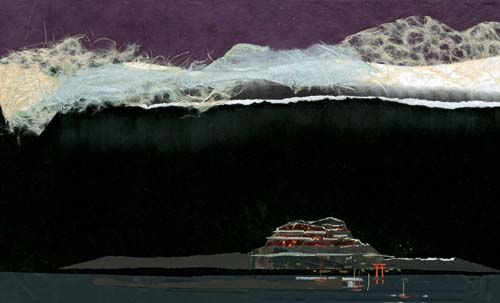
7-Imp: Describe your studio or usual work space for us.
Ed: My studio in about 40’ long by 10’ wide in a small barn with two sky-lights. I have a table along the length of the room so that I can see the whole book in pictures upon one glance in order to orchestrate the story. I usually work standing up so that I can move about freely. It is my place of centering and quietude—a haven.
7-Imp: What’s one thing that most people don’t know about you?
Ed: Although I enjoy talking with friends, I enjoy being in silence alone or with people where words often aren’t necessary. For this reason, dawn is my favorite time of day.
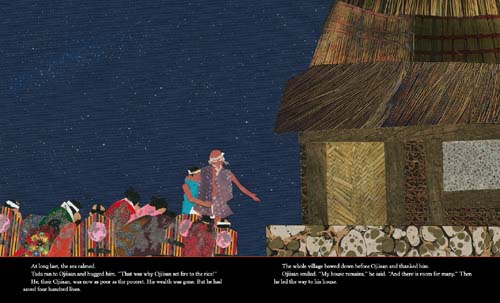
Then he led the way to his house.”
7-Imp: Who are some of your favorite contemporary Chinese-American illustrators/artists?
Ed: I don’t know any Chinese-American illustrators/artists by name, although I may know them by sight.
7-Imp: If you could have three (living) illustrators or author/illustrators — whom you have not yet met — over for coffee or a glass of rich, red wine, whom would you choose?
Ed: I do not engage well with superficial meeting, unless there’s a common task involved. Perhaps that is why I don’t drink coffee or wine.
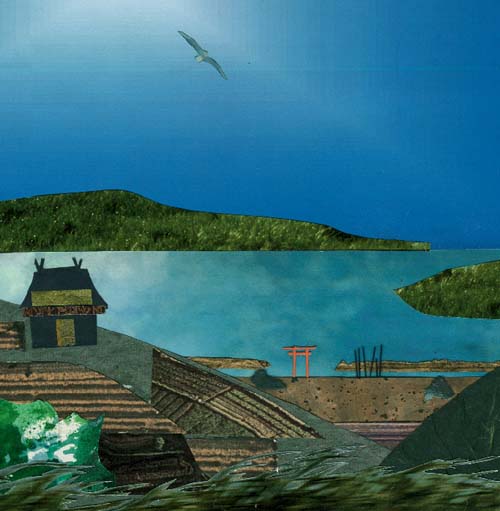
7-Imp: As book lovers, it interests us: What books or authors and/or illustrators influenced you as an early reader?
Ed: I loved Chinese historical novels while growing up in China. I also loved classical illustrators like Howard Pyle and N.C. Wyeth for their paintings.
7-Imp: We know this question must seem rather cliché, but we still find it interesting: What, if anything, do you consider the single most valuable piece of advice for an up-and-coming illustrator or author/illustrator today?
Ed: Do what you love. Over time it will set you free. Love what you do and you will leave the world a better place than the one you’ve found.
7-Imp: What books/projects are you currently working on that will come after Tsunami?
Ed: Currently, I have three books under contracts in their various stages of development: Moon Bears with Henry Holt, 7 Fathers with Roaring Brook, and Have Scissors, Will Travel with Chronicle Books.
Illustrations from TSUNAMI!: Tsunami! was written by Kimiko Kajikawa, illustrated by Ed Young, published by Philomel Books, a division of Penguin Young Readers Group (USA). Text copyright © 2009 by Kimiko Kajikawa. Illustration copyright © 2009 by Ed Young.
Illustrations from WABI SABI. Text copyright © 2008 by Mark Reibstein. Illustrations © 2008 by Ed Young. Reproduced by permission of the publisher, Little, Brown and Company Books for Young Readers, New York.
For more online information about Ed Young:
- Interview at Cynthia Leitich Smith’s Cynsations; December 11, 2008.
- Interview at Cynthia Leitich Smith’s Cynsations; December 7, 2005.
- Feature at Lee & Low Books at the release of Shanghai Messenger.
- Feature at Embracing the Child; Undated.
- Video interview from Lee & Low Books, posted September 2008:
- Little, Brown video interview with Ed Young at the release of Wabi Sabi:

This interview is quite sublime. So many of his responses resonated in a profound way: producing a book becomes part of the spirit of each person who touched it; do what you love, over time it will set you free; and the Pivot answers — Aha! and Heartless! Just wow.
The illos from Tsunami are also incredible, and especially illuminating was his comment on how art is taught in the East vs. the West. This can be applied to life in general, methinks.
Great questions, J and E! Thanks so much.
I have known Ed since 1968, and he is like fine wine, depths ever deepening, the glints and hints of essence consistent. Interesting that we both have the same take on doing what one loves and leaving the world therefore a better place. And aren’t we the incredibly lucky, favored folk to be able to do both.
What an inspirational interview. It’s a wonderful start to my week!
When I read a couple weeks ago that you were doing an Ed Young interview, my heart (as the saying goes) leapt up. Because I’m out of the kid-lit loop, I knew nothing at all about him until your Wabi Sabi coverage a couple months back — and that was all it took to convert me.
This interview (and Jane’s comment above) confirm that he must be a remarkable man as well as artist (all the more remarkable — at least to those of us who grew up in the West — because he probably would see nothing remarkable about himself).
“Heartless” as a curse word: boy, isn’t that true?
But I think my favorite quote of all he said here wasn’t from the interview proper, but in the run-up to it: “What are the seven impossible things?” If you de-couple it from the obvious context — I mean, 7-Imp itself — that question positively vibrates with mystery: a question a master would ask a student. I’m going to be thinking about that for a long time.
The image of the wall-to-wall tsunami minutes away from the village really lived up to its advance billing. [shuddering]
Thanks so much, as always, for sharing great illustrators, great authors, and great people here at 7-Imp!
Super, super cool art…love the interview, as always.
Young先生:
非常好看! 真的很漂亮。谢谢来7—IMP跟我们份额.
Jules & Eisha,
Thank you for this informative interview with one of the icons of children’s picture books. Young is a master of so many different media–watercolors, cut-paper, collage, pastels. He is definitely one of my favorite illustrators/artists.
About ten years ago, I wrote a picture book illustrator study on Ed Young for a children’s literature course I was taking. Once I got started on the project I couldn’t stop myself. I was supposed to evaluate 5 or 6 of his books–but I did 13 because I got so immersered in his work!
I believe Young gives the best advice when he says that we should do what we love. I think his passion for his work shines through in the magnificent books he has given us.
II just happened to also read a review of Wabi Sabi at http://100scopenotes.wordpress.com/2008/12/04/book-review-wabi-sabi/ today. I really need to get that book myself! This interview is fabulous, as always. What a fascinating man, and incredible artist! I have always loved his books.
Thanks for doing this interview! Lon Po Po still haunts me.
[…] African American heroes. A talk with Ed Young. Seven Impossible Things Before Breakfast posted an interesting interview (and great accompanying pics) with the Caldecott medalist behind books like Wabi Sabi and Lonpopo. […]
Thanks for this beautiful and inspiring interview, and for showcasing Ed Young’s masterpieces in such a thoughtful way.
[…] and all . . . Some of you may remember that it wasn’t too long ago that I posted the 7-Imp Ed Young interview. Well, he’s got a new book out, and I am so head-over-heels in love with it and the art […]
[…] In the meantime, I’m leaving you this week with some collage illustrations from the great Ed Young. His latest illustrated title is by Brenda Z. Guiberson, who has been writing and illustrating […]
[…] an interesting interview with Ed Young here at Seven Impossible Things Before Breakfast, where he talks about Wabi Sabi, and his other […]
[…] to learn more about Ed, who is a Caldecott Award medalist, you can visit his website or read this wonderful interview on the blog Seven Impossible […]
[…] an Ed Young kind of day here at […]
[…] Colón, Marla Frazee, and Jon Klasssen’s stuff is gorgeous. That tree house book — wow. Ed Young, the Dillons. Jim Kay’s work in A Monster Calls is one of the best things I’ve ever […]
[…] http://blaine.org/sevenimpossiblethings/?p=1576 […]
[…] Ed Young, R. Gregory Christie, David Gentleman. (And Xu Bing, who might not consider himself an illustrator, […]
[…] This morning over at my Kirkus column, I’ve got Barbara Dacosta and Ed Young’s new picture book, Mighty Moby (Little, Brown, August […]
[…] week, I wrote here about Barbara Dacosta and Ed Young’s Mighty Moby (Little, Brown, August 2017). I’ve got a bit of art from the book today, as well […]